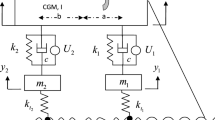Abstract
Adaptive Front-Lighting System (AFLS) is a system which assists driver's field of vision by automatically controlling its brightness and illumination angle to adapt various driving conditions such as climate, traffic, road changes and so forth. This paper aims to propose novel model-based PID gain design method to improve the performances of Dynamic Bending Light (DBL) module that change horizontal angle of a system by applying Brent-Dekker algorithm that finds the root of nonlinear function and implementing Nelder-Mead simplex algorithm to the system reduction process. Along with the linear system model-based control theory, motor dynamics were modeled with frequency response. Validation of the prototype resulted in having less than 3 % error from the simulation, where position initialization and the real-time status monitoring function is available due to the closed loop control which enables over 3 times faster response than the conventional open-loop system.
Similar content being viewed by others
Abbreviations
- r :
-
gear reduction ratio
- V 1L :
-
measured dead zone of motor system, V
- V 1H :
-
input voltage upper limit to motor system, V
- V 2L :
-
dead zone voltage after linearization, V
- V 2H :
-
input voltage upper limit after linearization, V
- v c :
-
controller command voltage, V
- V linout :
-
linearized command voltage, V
- ω m :
-
natural frequency of motor system, rad/s
- ζ m :
-
damping ratio of motor system
- K m :
-
electrical speed constant of motor system, V/rad/s
- a t :
-
tangential acceleration of vehicle at C.G.
- a n :
-
normal acceleration of vehicle at C.G.
- v :
-
forward velocity of vehicle
- ρ :
-
radius of curvature of vehicle trajectory
- K P in :
-
proportional gain of inner speed control loop
- K I in :
-
integral gain of inner speed control loop
- K D in :
-
derivative gain of inner speed control loop
- K P O :
-
proportional gain of outer angle control loop
- K D O :
-
derivative gain of outer angle control loop
References
Bedford, A. M. and Fowler, W. (2008). Engineering Mechanics Dynamics Fifth Edition in SI Units. 5th edn. Prentice Hall. New York, USA.
Dennis, J. E., Jr. and Schnabel, R. B. (1983). Numerical Methods for Unconstrained Optimization and Nonlinear Equations. Prentice-Hall. Englewood Cliffs, New Jersey, USA.
Guo, D., Gao, S., Wang, H. and Wang, J. (2011). Study on adaptive front-lighting system of automobile based on microcontroller. Proc. IEEE Int. Conf. Transportation, Mechanical, and Electrical Engineering (TMEE), Changchun, China.
Guo, F., Xiao, H. and Tang, S. (2013). Research of modeling and simulation on adaptive front-lighting system for corner based on CCD. Proc. IEEE 25th Chinese Control and Decision Conf., Guiyang, China.
Ishiguro, K. and Yamada, Y. (2004). Control technology for bending mode AFS. SAE Paper No. 2004–01–0441.
Jeffrey, C. L., James, A. R., Margaet, H. W. and Paul, E. W. (1998). Convergence properties of the nelder-mead simplex method in low dimensions. SIAM J. Optimization 9, 1, 112–147.
Kim, D., Choi, J., Lee, G. and Han, K. (2011). Study on optimized tuning in full AFLS head lamps. KSAE Annual Conf. Proc., Korean Society of Automotive Engineers, 1470–1479.
Kim, K. H., Yum, D. H., Byeon, D. K., Kim, D. Y. and Lee, D. I. (2010). Improving driver’s visual field using estimation of curvature. Proc. IEEE Int. Conf. Control, Automation and Systems (ICCAS), Gyeonggi, Korea.
Levy, E. C. (1959). Complex-curve fitting. IRE Trans. Automatic Control 4, 1, 37–43.
Li, L., Yang, M. and Zhang, J. (2015). The bending mode control method of AFS system based on preview control. Int. J. Smart Sensing and Intelligent Systems 8, 1, 637–657.
Shadeed, H. and Wallaschek, J. (2007). Concept of an intelligent adaptive vehicle front-lighting assistance system. Proc. IEEE Intelligent Vehicles Symp., Istanbul, Turkey.
Sivak, M., Schoettle, B., Flannagan, M. and Minoda, T. (2004). Optimal Strategies for Adaptive Curve Lighting. The University of Michigan Transportation Research Institute Technical Report. UMTRI-2004–22.
Author information
Authors and Affiliations
Corresponding author
Rights and permissions
About this article
Cite this article
Park, S.H., Im, B.U. & Park, D.K. Model Based Optimum Pid Gain Design of Adaptive Front Lighting System. Int.J Automot. Technol. 19, 923–933 (2018). https://doi.org/10.1007/s12239-018-0089-x
Received:
Revised:
Accepted:
Published:
Issue Date:
DOI: https://doi.org/10.1007/s12239-018-0089-x




